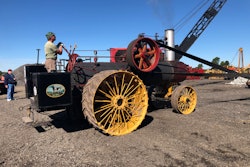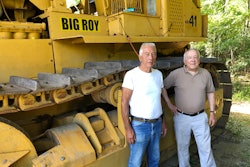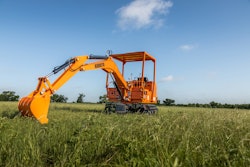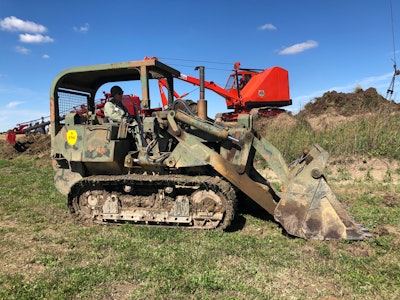
Jim Carter has preserved a piece of military history with his 1972 Case Marine Corps 1150 track loader, and he enjoys showing it to the public.
“Most people have seen the civilian models, but they've never seen something set up the way the military would have had it,” says the retired nuclear-medicine technologist from Zionsville, Indiana, who collects vintage equipment and trucks.
At last year’s Historical Construction Equipment Association annual convention, he went all out, not only demonstrating the MC1150’s abilities but also getting in costume with military fatigues and helmet.
“It's just something kind of fun,” he says. “I figured I would look a lot better running the machine in that outfit than I would in T-shirt and shorts and sandals or something.”
(To watch him operate the loader, check out the video at the end of this story.)
He even placed a replica of an M16 rifle in the loader’s side rack to add to the authentic look. “That garnered a lot of interesting comments from people. If you're an equipment operator out in the battlefield, you want your firearm close by.”
Another thing that attracts the crowds is the engine’s loud roar, which doesn’t sound like the typical Case engine – and that’s because it’s not a Case.
“The Marine Corps loves Detroit 2-cycle diesels, so they spec’d that machine with a 4-53 Detroit in it, which makes it very unusual.”
“You can always tell a Detroit engine when it's running full throttle,” he adds. “And that's what attracts a lot of people. … They love the roar of the old Detroit engines.”
That’s fine with Carter, who makes sure to wear his earplugs.
Made for Marines
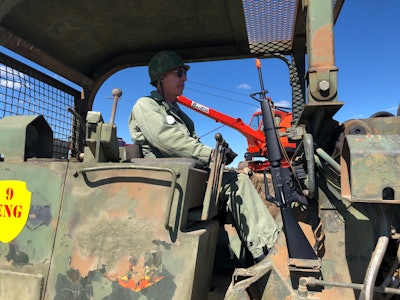 Jim Carter dresses the part to demonstrate his MC1150 track loader at the HCEA show, including his replica M16 in the rifle rack.Equipment World
Jim Carter dresses the part to demonstrate his MC1150 track loader at the HCEA show, including his replica M16 in the rifle rack.Equipment World
He loves the old military models and started that collection with a 5-ton military dump truck. About 10 years ago, he got a call from Fred Ropkey, then owner of the Ropkey Armor Museum in Crawfordsville, Indiana. Ropkey, who has since passed away, had bought the MC1150 from government surplus and had used it on the museum property. He offered to sell it to Carter.
“I hated to see that stuff go somewhere where it might be scrapped out, or somebody who just wanted to dig a pond and then forget about it,” Carter says.
So he bought it.
It ran, but there was a leak in the transmission. Many of the track pins were frozen, so both track rails had to be replaced.
“I ended up spending a lot of money on it,” Carter says of the repairs. “But it was too nice a piece to let go.”
The local Case dealer had a technician on staff who liked working on old equipment. “He took it under his wing and pulled it all apart and fixed the pieces that needed to be fixed. And it's been running great ever since.”
Through Case’s corporate archivist, Carter was able to get the owner’s manual for the MC1150. He learned it was a heavier-duty machine than the civilian version. It came with a 1.75-cubic-yard 4-in-1 bucket versus the civilian’s 1.5-cubic-yard. The later civilian model, the 1150B, got the larger bucket.
“The military, regardless of the make or model, they always took the multipurpose bucket, the 4-in-1, which tends to add weight and complexity to the machine," Carter says. "But, oh my, are those things handy.”
The loader also has a rack behind the operator’s seat for holding three jerry cans of extra fuel. The ROPS canopy was not original to Carter’s model but was added later by the Marine Corps.
Another interesting thing about the loader is you can turn the machine without the pedals by using the levers to run one track forward and one in reverse; it can counterrotate.
As to how it runs, Carter is a fan.
“It's one of the few tractors that I actually enjoy running,” he says. “… I feel like I'm being beat to death when I run a lot of the other bulldozers, but that machine is actually a pleasure to run.”
Military salute
Carter doesn’t see many military machines at the vintage shows he attends. He noted that when he was researching the estimated cost of the MC1150 before he bought it, he didn’t come across many on the web.
“I found two or three others online that people had for sale, but they all had been modified in one form or another to fit a more civilian market. Usually the first thing they did was take the winch off the back, and they figured out a way to put some kind of a ripper on it instead.
“They didn't like the green, the old olive-drab paint, so they painted it yellow or something, so you would never recognize it as being a military machine.”
Carter prefers to keep his military equipment as true to the original as possible and likes their rarity.
“Every once in a while, at one of our shows somebody will have something that is or was military, but it's a microcosm,” he says. “If you think think our hobby of collecting the old stuff is small potatoes compared to like automobiles, the military versions of it are almost nonexistent. You just don't find it.”
Carter says he’s not actively pursuing more old equipment. In fact, he’s looking to pass along his MC1150 to someone willing to keep it up.
“It's an interesting machine. I’m glad I kept it,” he says. “I hope to someday pass it on to somebody else who will keep it running.”
“I hate to see this stuff destroyed,” he adds, “because it's just part of history.”
Check out this video of Carter digging with his MC1150 at the HCEA annual convention:





